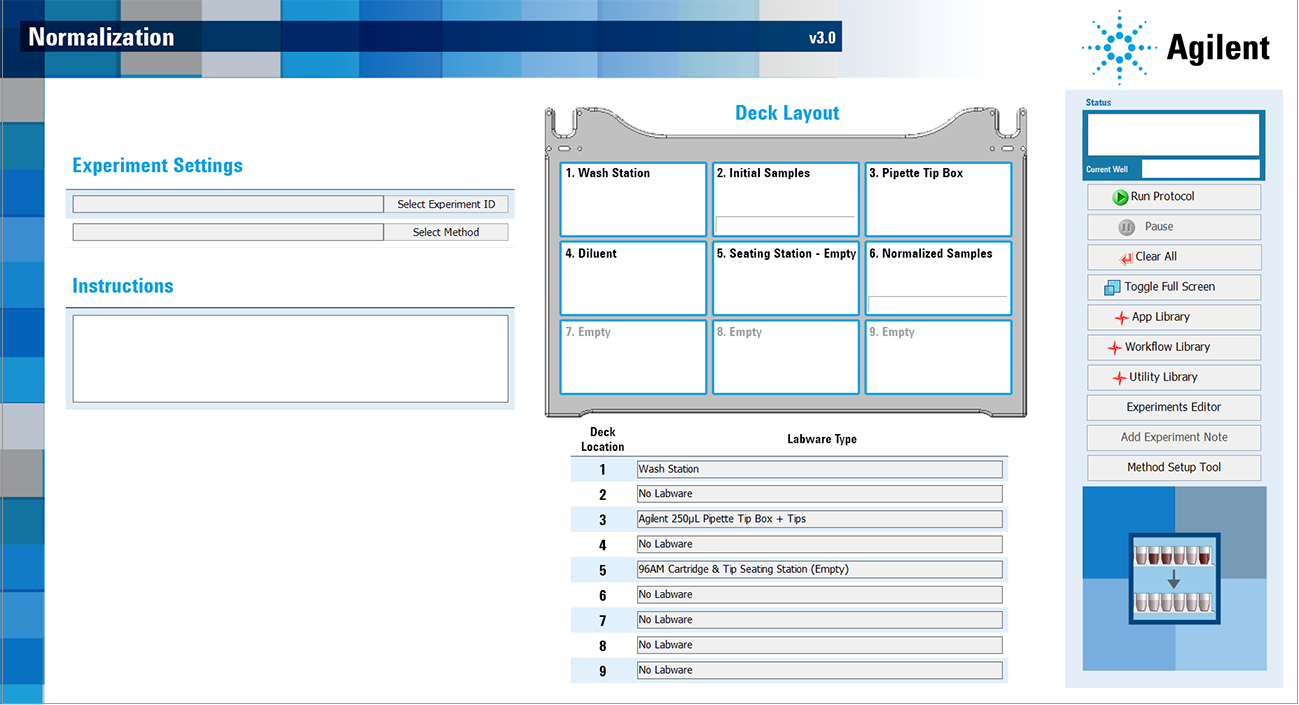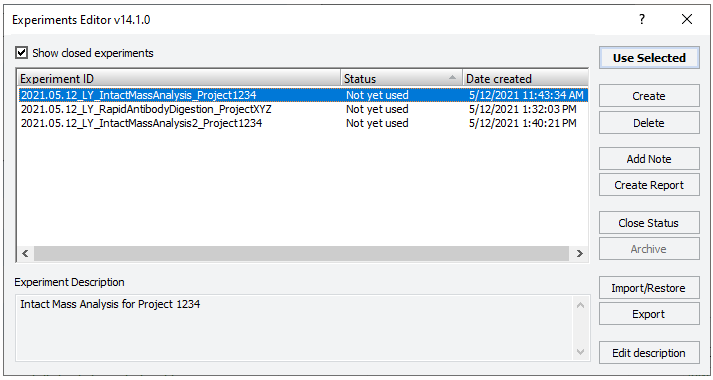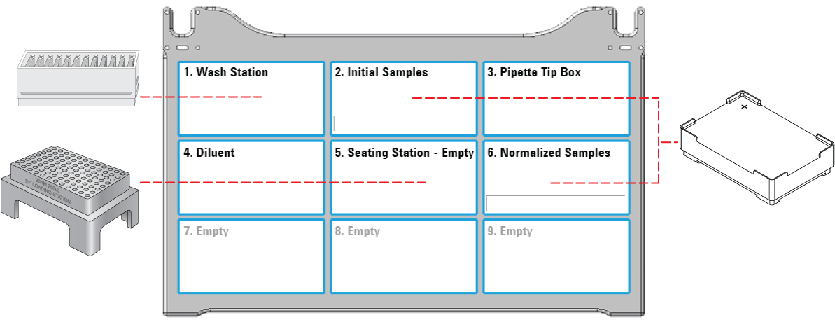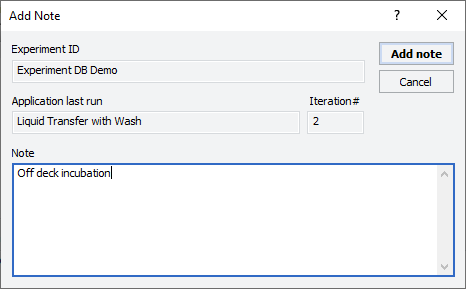Running the protocol

The Normalization protocol does the following:
• Washes and dries the syringes.
• Transfers diluent and sample to the normalized plate.
• Mixes all the samples in the normalized plate.
Experiment ID and method requirements
Each workbench application and utility has an Experiment Settings section that allows you to select an experiment ID and a method.
• An experiment ID is a database record that captures the steps executed and the settings used during each run of an application or utility. Any errors that may have occurred during a run are also recorded.
To create an experiment ID, you open the Experiments Editor by clicking  in any Workbench app or utility. For details, go to the Literature Library and open Using the Protein Sample Prep Workbench. In the browser that opens, click Using Experiment IDs.
in any Workbench app or utility. For details, go to the Literature Library and open Using the Protein Sample Prep Workbench. In the browser that opens, click Using Experiment IDs.
 in any Workbench app or utility. For details, go to the Literature Library and open Using the Protein Sample Prep Workbench. In the browser that opens, click Using Experiment IDs.
in any Workbench app or utility. For details, go to the Literature Library and open Using the Protein Sample Prep Workbench. In the browser that opens, click Using Experiment IDs.• A method is a comprehensive collection of saved settings for an application or utility, which you can use to run the application or utility.
Experiment IDs and methods are required for compliance-enabled VWorks editions and optional for noncompliance-enabled VWorks editions.
VWorks edition | Experiment ID and method selection |
|---|---|
VWorks Plus | Required |
VWorks Standard | Optional |
Before you start
Ensure that you:
• Prepare the Normalization Setup Method. See Setting up a Normalization method.
• Display the method’s labware selections and diluent and sample preparation instructions by doing one of the following:
– Open the Normalization utility and select the method. For details, see Setting up the protocol.
– Export the method and view it in Microsoft Excel. For details, see Exporting and importing AssayMAP methods.
• Prepare the diluent and samples. See Preparing the diluent and samples.
• If applicable, make sure that you know which experiment ID to use to record the steps executed during the utility and app runs.
• Run the Startup protocol to prepare the AssayMAP Bravo Platform for the run. See the System Startup/Shutdown v3.0 User Guide utility.
Setting up the protocol
Before starting the protocol, make sure the appropriate selections and values are specified in the Normalization utility.
To set up the protocol:
1 Open the Utility Library.
2 Locate Normalization, and then click Utility.
 |
The Normalization utility opens.
 |
3 If applicable, click Select Experiment ID.
 |
The Experiments Editor opens.
 |
4 Select the Experiment ID that you want to use to record the steps performed during this application run, and then click Use Selected.
The Experiments Editor closes.
5 In the form, click Select Method to locate and select a method.
In the Open File dialog box, select the method, and click Open.
The form displays the method labware selections and diluent preparation instructions.
• To run the selected method, go to Starting the protocol run.
• To create or modify a method, see Setting up a Normalization method.
VWorks Plus. Administrator or technician privileges are required to create and modify methods.
About performing a mock run (optional)
If you are unfamiliar with the protocol and would like to see how it operates before running it with valuable samples and reagents, you can perform a mock run. A mock run uses empty or water-filled labware and source bottles.
You prepare for a mock run the same way you would prepare for a real protocol run, except that you use empty labware for a totally dry run or labware containing water for a wet run. You must use pipette tips for the mock run.
Starting the protocol run
To start the protocol run:
1 Ensure that the accessories and labware are at the assigned deck locations, as shown in the Deck Layout image of the form.
• The Bravo Plate Risers are securely in place at deck locations 2 and 6. The initial samples plate is seated on the Bravo Plate Riser at deck location 2. The normalized samples plate is seated on the Bravo Plate Riser at deck location 6.
• The Diluent reservoir is at deck location 4.
• The tip box full of fresh pipette tips is at deck location 3 and the empty 96AM Cartridge & Tip Seating Station is at deck location 5.
Note: A full tip box is required for each run even if the run uses less than 96 pipette tips.
Note: The protocol will transfer the pipette tips to the seating station.
 |
2 Click  to start the run.
to start the run.
 to start the run.
to start the run. To monitor the progress of the run, check the Status box.
 |
Note: After the protocol run starts, you can walk away from the AssayMAP Bravo Platform for the duration of the protocol. In general, 96 samples requires approximately 110 minutes.
To pause the run, click Pause. The task currently in progress finishes before the protocol pauses. The Scheduler Paused dialog box opens. For details, see Emergency stops and pauses.
To troubleshoot errors, see the Error Recovery Guide and the Bravo Platform User Guide in the Literature Library page of the Protein Sample Prep Workbench.
Adding an experiment ID note after the run
After the protocol run ends or during a pause, you can add a note to the experiment ID. For example, a note can describe any observations during the run or any offline steps that are being executed. The notes that you add will appear in any reports generated for the experiment ID.
To add a note to an open experiment ID:
1 While the experiment ID is still selected in the Experiment Settings area, click  . The Add Note dialog box opens.
. The Add Note dialog box opens.
 . The Add Note dialog box opens.
. The Add Note dialog box opens. |
2 In the Note area, type the note, and then click OK.
For detailed instructions on working with Experiment IDs, see Using Experiment IDs.
Cleaning up
To clean up after a run:
1 Remove used labware from the deck.
2 Discard leftover reagents appropriately.
3 Optional. Conduct stringent washing of the syringes:
a Open the Syringe Wash utility  .
.
 .
.b If applicable, click Select Experiment ID to open the Experiments Editor.
 |
c In the Experiments Editor, select the Experiment ID that you want to use to capture the steps performed during this utility run, and then click Use Selected.
d Click Select Method to select and load the method for this utility.
e Confirm that the labware and accessories on the AssayMAP Bravo deck match the display in the Deck Layout area of the form.
f Click  to start the run.
to start the run.
 to start the run.
to start the run.To shut down at the end of the day:
Run the System Shutdown utility. See System Startup/Shutdown v3.0 User Guide.